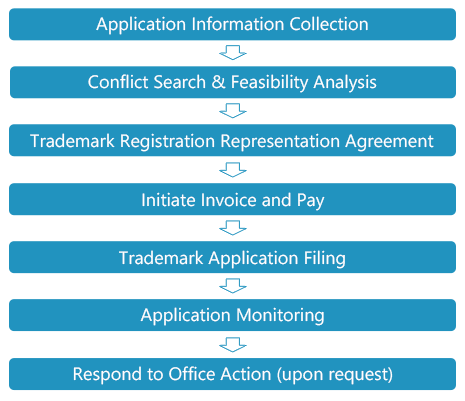


# Take a few minutes to complete the Trademark Questionnaire.
# We provide free conflict search and application consult.
# The Agreement establishes the legal representation relationship.
# We will initiate an invoice for your payment. (Pricing Summary)
# Professional attorneys will file the application for you.
# We will monitor the application and keep you updated.
# Possible office actions need professional responses by the attorney.



1. Identify your trademark
You can apply to register your trademark as a standard character trademark or a special form trademark. The type you choose affects your scope of protection and your submission requirements.
A standard character trademark requires very little information, while a color special form trademark requires you to submit a JPG version of the trademark, a color claim, and a description of the trademark that includes where in the trademark the colors are located.
Once you submit your application, you cannot change to a different trademark or materially alter the trademark you submitted.
2. Trademark clearance search
A trademark can be registered only when it meets the USPTO rules and regulations.
"Likelihood of confusion" is the most common reason that most trademark applications are rejected. So a suitable "clearance search" is essential before the application. Read Question ② for more knowledge.
The USPTO has more rules and regulations for a trademark. You may consult an expert attorney for advice.
3. Identify and classify your goods or services
The number of classes of goods or services you include in your application affects how much your application costs. Once you file your initial application, you cannot expand the scope of your goods or services. You can only narrow or delete them.
Read Question ④ for more knowledge.
4. Submit specimens as evidence of use
To register a U.S. trademark, you are required to provide Evidence of Use to the trademark. Specifically, you must submit specimens in the application sooner or later according to the filing basis of your application. (Read Question ③ for more knowledge.)
In practice, we recommend you provide both of the following types of specimens:
One or more clear pictures of your goods or packaging where your trademark or Logo shows up;
One or more web links where people can purchase your goods or services. The web page should include buttons like "Add to cart" and "Buy now".
Clearance search also called "conflict search" or "knockout search", means a search you complete before applying for a trademark registration to make sure your trademark is available to register for your particular goods or services, and to make sure that no other trademark conflicts with it.
One of the most common reasons trademark applications are rejected is because the applied-for trademark is too similar to an already registered one and there's a likelihood of confusion. This means that customers are likely to think your goods or services come from the same source as another party's goods or services. So, before you apply to register a trademark, search to see if someone else already registered that trademark or a similar one.
By researching whether someone has already registered or applied for the trademark you want, you can help avoid costly and time-consuming issues. You can also find out if the trademark you want is too similar to someone else's.
"Use in commerce" and "Intent to use" are two types of filing basis, they have different meanings and requirements.
Use in commerce
Use in commerce means using your trademark in selling or transporting your goods out of state or in providing services to customers who live outside your state.
To register your trademark, you'll need to provide evidence that you're using it in commerce. This means you'll need to submit a specimen showing how you use your trademark. You'll also need to provide the date you first used your trademark in commerce and the date you first used it anywhere.
Intent to use
Intent to use means that you haven't started using your trademark in commerce, but you have a bona fide intent to do so within the next three to four years.
Although you can apply to register your trademark with an intent-to-use basis, you cannot actually register your trademark until you show that you've started using it in commerce.
Differences in practice:
In case your intend-to-use application is approved by the USPTO, you are required to file a "Statement of Use" and submit specimens in the required period of time.
Use-in-commerce applications do not require a "Statement of Use".
Filing a "Statement of Use" will be charged by USPTO, and you probably need paid assistance from an attorney in this case.
Notes: Once you file your initial application, you cannot expand the scope of your goods or services. You can only narrow or delete them.
You can use the Trademark ID Manual to identify and classify what goods or services you're offering.
Or you can download files for assistance from the following categories:
Categories of Goods:
Class 01 Chemicals used in industry, science and photography, as well as in agriculture, horticulture and forestry; unprocessed artificial resins, unprocessed plastics; manures; fire extinguishing compositions; tempering and soldering preparations; chemical substances for preserving foodstuffs; tanning substances; adhesives used in industry.
Class 02 Paints, varnishes, lacquers; preservatives against rust and against deterioration of wood; colorants; mordants; raw natural resins; metals in foil and powder form for painters, decorators, printers and artists.
Class 03 Bleaching preparations and other substances for laundry use; cleaning, polishing, scouring and abrasive preparations; soaps; perfumery, essential oils, cosmetics, hair lotions; dentifrices.
Class 04 Industrial oils and greases; lubricants; dust absorbing, wetting and binding compositions; fuels (including motor spirit) and illuminants; candles and wicks for lighting.
Class 05 Pharmaceutical and veterinary preparations; sanitary preparations for medical purposes; dietetic substances adapted for medical use, food for babies; plasters, materials for dressings; material for stopping teeth, dental wax; disinfectants; preparations for destroying vermin; fungicides, herbicides.
Class 06 Common metals and their alloys; metal building materials; transportable buildings of metal; materials of metal for railway tracks; non-electric cables and wires of common metal; ironmongery, small items of metal hardware; pipes and tubes of metal; safes; goods of common metal not included in other classes; ores.
Class 07 Machines and machine tools; motors and engines (except for land vehicles); machine coupling and transmission components (except for land vehicles); agricultural implements other than hand-operated; incubators for eggs.
Class 07 Hand tools and implements (hand-operated); cutlery; side arms; razors.
Class 08 Scientific, nautical, surveying, photographic, cinematographic, optical, weighing, measuring, signalling, checking (supervision), life-saving and teaching apparatus and instruments; apparatus and instruments for conducting, switching, transforming, accumulating, regulating or controlling electricity; apparatus for recording, transmission or reproduction of sound or images; magnetic data carriers, recording discs; automatic vending machines and mechanisms for coin-operated apparatus; cash registers, calculating machines, data processing equipment and computers; fire-extinguishing apparatus.
Class 09 Surgical, medical, dental and veterinary apparatus and instruments, artificial limbs, eyes and teeth; orthopedic articles; suture materials.
Class 10 Apparatus for lighting, heating, steam generating, cooking, refrigerating, drying, ventilating, water supply and sanitary purposes.
Class 11 Apparatus and installations for lighting, heating, cooling, steam generating, cooking, drying, ventilating, water supply and sanitary purposes.
Class 12 Vehicles; apparatus for locomotion by land, air or water.
Class 13 Firearms; ammunition and projectiles; explosives; fireworks.
Class 14 Precious metals and their alloys and goods in precious metals or coated therewith, not included in other classes; jewellery, precious stones; horological and chronometric instruments.
Class 15 Musical instruments.
Class 16 Paper, cardboard and goods made from these materials, not included in other classes; printed matter; bookbinding material; photographs; stationery; adhesives for stationery or household purposes; artists' materials; paint brushes; typewriters and office requisites (except furniture); instructional and teaching material (except apparatus); plastic materials for packaging (not included in other classes); printers' type; printing blocks.
Class 17 Rubber, gutta-percha, gum, asbestos, mica and goods made from these materials and not included in other classes; plastics in extruded form for use in manufacture; packing, stopping and insulating materials; flexible pipes, not of metal.
Class 18 Leather and imitations of leather, and goods made of these materials and not included in other classes; animal skins, hides; trunks and travelling bags; umbrellas, parasols and walking sticks; whips, harness and saddlery.
Class 19 Building materials (non-metallic); non-metallic rigid pipes for building; asphalt, pitch and bitumen; non-metallic transportable buildings; monuments, not of metal.
Class 20 Furniture, mirrors, picture frames; goods (not included in other classes) of wood, cork, reed, cane, wicker, horn, bone, ivory, whalebone, shell, amber, mother-of-pearl, meerschaum and substitutes for all these materials, or of plastics.
Class 21 Household or kitchen utensils and containers; combs and sponges; brushes (except paint brushes); brush-making materials; articles for cleaning purposes; steelwool; unworked or semi-worked glass (except glass used in building); glassware, porcelain and earthenware not included in other classes.
Class 22 Ropes, string, nets, tents, awnings, tarpaulins, sails, sacks and bags (not included in other classes); padding and stuffing materials (except of rubber or plastics); raw fibrous textile materials.
Class 23 Yarns and threads, for textile use.
Class 24 Textiles and textile goods, not included in other classes; bed and table covers.
Class 25 Clothing, footwear, headgear.
Class 26 Lace and embroidery, ribbons and braid; buttons, hooks and eyes, pins and needles; artificial flowers.
Class 27 Carpets, rugs, mats and matting, linoleum and other materials for covering existing floors; wall hangings (non-textile).
Class 28 Games, toys and playthings; video game apparatus; gymnastic and sporting articles; decorations for Christmas trees.
Class 29 Meat, fish, poultry and game; meat extracts; preserved, frozen, dried and cooked fruits and vegetables; jellies, jams, compotes; eggs; milk and milk products; edible oils and fats.
Class 30 Coffee, tea, cocoa and artificial coffee; rice; tapioca and sago; flour and preparations made from cereals; bread, pastries and confectionery; edible ices; sugar, honey, treacle; yeast, baking-powder; salt; mustard; vinegar, sauces (condiments); spices; ice.
Class 31 Raw and unprocessed agricultural, aquacultural, horticultural and forestry products; raw and unprocessed grains and seeds; fresh fruits and vegetables, fresh herbs; natural plants and flowers; bulbs, seedlings and seeds for planting; live animals; foodstuffs and beverages for animals; malt.
Class 32 Beers; mineral and aerated waters and other non-alcoholic beverages; fruit beverages and fruit juices; syrups and other preparations for making beverages.
Class 33 Alcoholic beverages (except beers).
Class 34 Tobacco; smokers' articles; matches.
Categories of Services:
Class 35 Advertising; business management; business administration; office functions.
Class 36 Insurance; financial affairs; monetary affairs; real estate affairs.
Class 37 Building construction; repair; installation services.
Class 38 Telecommunications.
Class 39 Transport; packaging and storage of goods; travel arrangement.
Class 40 Treatment of materials.
Class 41 Education; providing of training; entertainment; sporting and cultural activities.
Class 42 Scientific and technological services and research and design relating thereto; industrial analysis and research services; design and development of computer hardware and software.
Class 43 Services for providing food and drink; temporary accommodation.
Class 44 Medical services; veterinary services; hygienic and beauty care for human beings or animals; agriculture, horticulture and forestry services.
Class 45 Legal services; security services for the physical protection of tangible property and individuals; personal and social services rendered by others to meet the needs of individuals.
How long does a federal registration last?
Your trademark registration can last forever, so long as you continue to use your trademark in commerce and provide the USPTO with evidence that you're still using it. Specifically, you need to file maintenance documents with fees at prescribed, periodic intervals.
If you don't maintain your trademark registration at these intervals, you'll lose your federal registration and will need to start the application process over.
How to keep your registered trademark valid and lasting?
According to the USPTO rules, you need to continuously use the registered trademark in commerce; and
File a "Declaration of Use", specimen, and fee on a date that falls on or between the fifth (5th) and sixth (6th) anniversaries of the registration; and
File a "Declaration of Use", specimen, and fee on date that falls on or between the ninth (9th) and tenth (10th) anniversaries of the registration, and each successive ten-year period thereafter.
Failure to file the documents and fees will result in cancellation/expiration of the registration.
Email to tr@TrademarkSea.com and let our attorneys to do this technical work representing you - fees starts from $100/class.